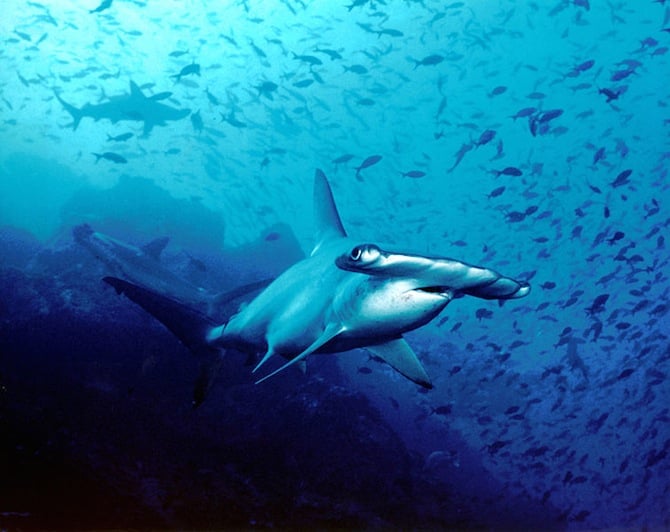Wildlife Adventures: Swimming With Sharks And Sea Lions In The Galapagos Islands

Hammerhead shark. Photo courtesy of Barry Peters.
Isla Lobos
Our first stop is Isla Lobos — an attraction that no Galapagos travel guide or Ecuador travel guide would be complete without mentioning. The site features a small but pristine island, and a protected channel known for its plethora of sea lions. Here, the visibility is amazing, as you could see every fish, sea turtle and sea iguana very clearly – almost too clearly. “Do you see how those fish all come together and disperse with a lot of white things?” asks Jens. “That’s sperm. They’re making rock and roll.”
Sea lions. Photo courtesy of moments in nature.
Kicker Rock
Our next stop is Kicker Rock, a massive rock formation rising 500 feet out of the water and taking on the appearance of a león dormido, or sleeping lion. It’s also the site of my shark encounter. The guide tells me that sometimes there are almost 100 sharks, so only encountering six for the day isn’t a lot. As I’m used to encountering zero, I beg to differ; however, the Galapagos sharks, blacktip sharks, white tip sharks and hammerheads that reside near Kicker Rock, while large in size, are virtually harmless to humans. That knowledge does nothing, however, to keep my blood from running cold every time one comes within 10 feet of me. Once we leave Kicker Rock, however, I realize how lucky I am to have had such a unique experience. And, along with the sharks, the Chocolate Chip starfish, sea turtles and an array of tropical fish and colorful corals remind me I’m in one of the most beautiful and ecologically diverse places in the world.Puerto Grande
For lunch we make a stop at the serene beach of Puerto Grande. The food is great, a huge helping of rice with tender chunks of beef. Once we’ve digested a bit, the group descends into the warm, clear water and makes our way to the beach for a short informational hike. The beach is covered in hermit crabs, diverse pieces of shell and perfect white sand. Apparently, the sand gets its color from the chunks of white coral that lay upon the beach. We make one more stop at Kicker Rock for a bit more snorkeling and diving – and more shark encounters – before heading back home. As I lay on the bow of the boat, bathing in the last of the day’s sunlight, I hear a loud splash in front of me. Looking up, a breaching whale jumps out of the water, and I slowly watch its tail sink back below. This place really is unlike any other on Earth. Travel Tip: If visiting the Galapagos Islands and interested in doing this tour, it was given by Dive Surf Club, although you can book through any agency as the whole island works together. The guides are hysterical, fun and have a lot of knowledge. It’s $50 to snorkel and $120 to dive, including naturalist guides, dive instructors, snacks, drinks and lunch. *This article originally appeared on Gadling
Hi, I’m Jessie on a journey!
I'm a conscious solo traveler on a mission to take you beyond the guidebook to inspire you to live your best life through travel. Come join me!

Want to live your best life through travel?
Subscribe for FREE access to my library of fun blogging worksheets and learn how to get paid to travel more!


Oh wow, the sharks would have scared me too! But that sounds incredible, especially the playful sea lions!
@Erin: Yea, and all in the wild. No cages or seals/dolphins living in small spaces. Just wide open freedom! 🙂
Love the photo of the hammerhead! Your post brings back such great memories! I had the most incredible dives of my life in the Galapagos when I did an 8 day live-abroad dive trip there a few years ago.
@Laurel: The trip definitely made me think more about getting dive certified. I only snorkeled this particular time, but maybe in the future…:)
This sounds incredible! Swimming with sharks in the Galapagos has always been a dream of mine.